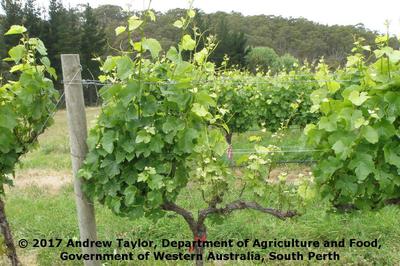Dead Arm
Eutypa lata
Fungus
In a Nutshell
- Disease characterized by the internal rot of the trunk.
- Cross-sections of the trunk show a wedge-shaped canker of the internal tissues.
- Possible symptoms on leaves include the formation of chlorotic patches, necrotic margins and cupping of the lamina.
Can also be found in
Symptoms
This disease is characterized by the internal rot of the trunk. As the disease progresses over the years, one or more arms may die, thereby the name "deadarm". Cross-sections of the trunk show a wedge-shaped canker of the internal tissues. Fungal growth can sometimes be observed forming charcoal patches on the bark of the dead wood. This disease may also present symptoms on leaves. These include the spotting of leaf blade and the subsequent formation of chlorotic patches and necrotic margins. Deformation and cupping of the lamina ensue. Internodes are shortened and shoots grow stunted and chlorotic. Bunches may not initiate or simply do not develop and drop.
Recommendations

Organic Control
Commercial formulations based on Bacillus subtilis can be applied to the pruning wounds for protection. Copper-based products applied topically after pruning will also prevent fungal infection on open wounds.

Chemical Control
Always consider an integrated approach with preventive measures together with biological treatment if available. Myclobutanil, thiophanate-methyl and tetraconazole have been used to control trunk canker diseases including Eutypa dieback. They can be applied preventively immediately after pruning. Wound sealant with 5% boric acid in acrylic paint or essential oils also work fine.
What caused it?
The disease is caused by the fungus Eutypa lata, and is usually observed on older vineyards or orchards. The primary sources of infection are the fungal spores overwintering in contaminated trunks. In the spring, the release of these spores is favored by rain splashes and they are spread to the unfolded buds via wind. There, they enter the plant either through wounds or probably also directly through the stomatal pores. Once inside the wood, it spreads slowly and, over the years, can affect the vascular tissue. At advanced stages, it can completely girdle the shoots or branches, blocking water and nutrient transport to the upper parts of the vine or tree. Optimal temperatures for spore germination range from 20 °C to 25 °C. Eutypa lata can also infect apple, pear, and cherry trees as well as walnuts. An long series of trees such as mountain ash, cork oak or blackthorn complete the list of hosts and can act as a reservoir of inoculum.
Preventive Measures
- Monitor the field for signs of the disease and mark infected vines for removal.
- Be sure to remove and destroy old vine residues in the field.
- Avoid pruning during and after wet weather.
- Cut the infected branch under the canker and allow the growth of a new healthy shoot.
- Delayed pruning or double pruning are also effective methods to lower the infection.



